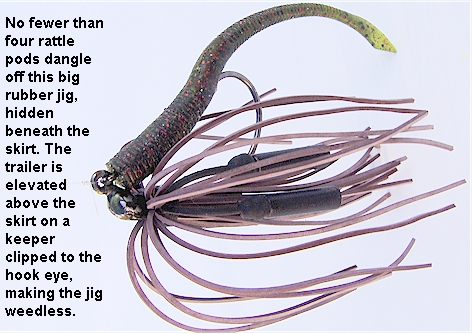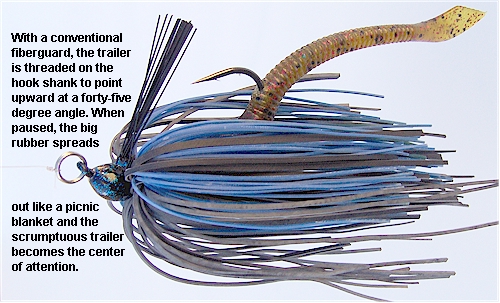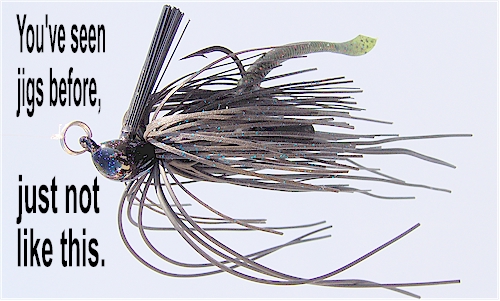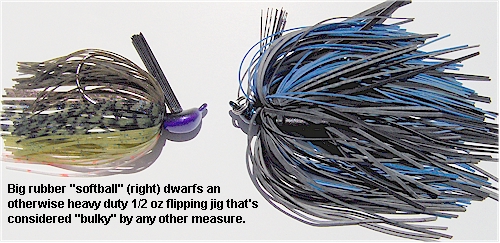Big Rubber
For
those who like to follow pros, Davy Hite is truly a legend of our
sport. In spring 2006. Hite bounced a big rubber jig, uniquely
styled with extra long, super thick strands according to local
custom, to win the Elite Series event this past weekend at Clark
Hill Lake on the border of South Carolina and Georgia near
Augusta.
You've
surely seen flipping jigs before, but chances are, you've never
seen jigs like Hite threw in that tournament, and you may never
see them again. Not unless Hite and his cronies on the BASS tour
continue to toss big rubber, but that's not likely.
Big
rubber is something Stephen Bayazes of Belvedere, South Carolina
turned me onto a while back. I often wished to write of it, but
never did because big rubber is so far out of the ordinary for
99% of readers, they'd summarily dismiss it as not pertinent to
them. All that changed momentarily when Davy Hite beat one
hundred of the world's elite anglers with big rubber. Hite's
success made it instantly of interest to every avid bass angler
who now wants to know all about big rubber... if only for the
moment.

You've seen jigs
before, just never like these. Unless you are a weekend
tournament angler who fishes in the vicinity of Belvedere, South
Carolina, then you may have seen them - in your worst nightmares.
Belvedere is across
the Savannah River from Augusta, Georgia and Clark Hill Lake
where Davy Hite just won the Elite Series event on jigs like
these.
Belvedere is also
home to Stephen Bayazes Jr who operates the Superbass tackle
store and makes custom jigs and spinnerbaits. He's the gent whose
jigs are shown here. "This rubber has to be imported from
Japan. It is custom made in order to get this thickness. People
around here have already run out of the green pumpkin, and the
guy who imports it says it'll be months before more gets here.
I'm glad I still have twenty pounds of brown rubber in
stock," says Bayazes.
"If you are
going to win a tournament around here, you need a big bait, and
this jig is something local anglers came up with to do
that," claims Bayazes who has held nine world records for
Savannah River species like stripers and hybrids, all caught with
jigs.
"Jack Clements
is the gentleman who taught me how to make jigs and
spinnerbaits," says Bayazes. "Papa Jack as we call him
is in his seventies now. He's the most humble human being I've
ever met, but Papa Jack is the first I know to use the big
rubber, making jigs with it on his kitchen table since the early
seventies. One of the first local anglers to make a name with the
big rubber, Greg Lovelace spearheaded that. He'd make up an Arkie
style jig with a big old hook and the big brown rubber. Greg has
spanked everybody in tournaments on Murray, Santee and Clark Hill
with that big rubber jig for the last ten years," says
Stephen.
"Greg's not
alone though. Top guys here such as Joey Zielinski and Norman
Adway, they were key in evolving the use of the big rubber too.
For the last ten years, these gentlemen have won more boats and
they've won every tournament you could ever think about winning
around here. They've spanked everybody and all they ever do is
throw jigs. The key is simple and this - the big rubber produces
about a four pound average fish around here, and I don't know of
many other lures that will do that," says Stephen.
"You're going to fish for five to seven bites are all, but
they're going to average three to five pounds apiece, on up to
ten and eleven pounders."

"That big
rubber, throw it in the water and the rubber comes alive, walks
away from the body and does a dance on it. Each strand absolutely
just bounces vibrantly," exclaims Stephen.
As bulky and extra
long as the skirt is, Bayazes relies on a surprisingly small
trailer. "The big rubber brings them over. It's the
attraction at first. But when you pause that jig, there's rubber
nowhere around it. It takes about two seconds for that rubber to
expand all the way out, and the trailer is revealed. That's the
prize morsel. When a four or five pound bass sees that succulent
worm, the rest of the bait, the rubber, it just becomes
secondary. It's like an oyster shell opening up to reveal a pearl
inside. So that's the reason why a small trailer works,"
says Bayazes.
Another thing Stephen
likes to do is get his trailer above the rubber, so the small
trailer is never lost in the skirt. He either affixes a trailer
keeper to the hook eye making the jig weedless, or else he
threads the trailer up the hook bend so it's held upward at a
forty-five degree angle. "Fish just don't have to kiss the
dirt and the elevated trailer gives them a strike target separate
and apart from the skirt. The trailer is what they lock their
sights on."
"My favorite
trailers are several sizes of Gary Yamamoto's Kut Tail Worms. I
can use the skinnier smaller Kut Tails as is, and I get a lot of
wiggling action out of these slender sizes. On the bigger Kut
Tails, I can use them too, but always pinch the thicker head
sections off, leaving only the slanky tail parts to thread on the
jigs. One way it helps to think of this thick jig and thin worm
combination is you are using the jig, the skirt and all that as a
picnic blanket spread out to attract a big fish to a finesse worm
that it would otherwise not have bothered with or not have
found."
Many weekend
tournaments in this neck of the woods are held on summer nights.
"You have got to have sound and vibration in a jig at
night," Bayazes emphasizes. "At night you've got to
have rattles. It would be perfect if you could get a jig to sound
like a Bill Lewis Rat-L-Trap, but there's only so many rattles
one can put on a jig."
"Four rattles is
about standard at night. When you pop that jig out from hydrilla
onto rocks, just keep working the rod tip so it bounces back and
forth causing the rattles to click on the rocks. It just sings to
them. That's usually when it gets hit," smiles Stephen.

"Indeed, areas
combining weeds with rocks are the best spots for rattling big
rubber. You can have rock pockets hidden inside weed beds where
the weeds can't grow except around the rocks. You may know those
rocks are down there in the weeds, but not exactly sure just
where until the jig starts clicking. You're in a rock pocket
then, and just slow way, way down and shake that thing, make that
sweet music. Or you can have edges and transitions where weed
beds meet gravel or rock. Ripping the big rubber through the
weeds out onto the rocks is the ticket," says Bayazes.
"Several
different jig head styles are used down here, but the Arkie style
goes through weeds and rock better than any others. The Arkie
profile stands up and keeps that worm tail held high up there
like a proud flag waving. Other jig styles, they tend to turn
over on their sides coming through grass and rocks. That taint no
good'" says Bayazes.
"When the water
is clear at night and the moon is out, black/blue is terrific. On
an overcast or moonless night, straight black. In the daytime,
green pumpkin or brown are often used. Jig fishing down here is
fundamental. Add in tomato seed and cherry seed, and you can
throw the rest of them [other colors] away," says he.
And while many
anglers can't make up their minds whether red hooks work, Bayazes
is a firm believer. "Especially at night, it [the red hook]
separates the men from the boys."
"We only use big
hooks on these jigs, even the light weight jigs have about the
biggest 5/0 you can find. You get a faster hook set when a fish
has a hook that big in its mouth."

Another thing you may
not have seen before, Bayazes often using split rings on his jig
hook eyes. This practice evolved for night fighting. "At
night, you can't see and you can't easily counter what a fish is
doing to throw the jig. With the split ring, a fish can work his
head from left to right, and all the pressure is on the loose
split ring, not direct pressure on the jig head it's trying to
knock loose. You get three hundred and sixty degrees of movement.
No pressure on the jig head or hook. All the pressure is on the
the line, and the loose split ring can stop fish from having any
direct movement of the line like when it's tightly-knotted to the
jig."
Chances are, you've
never seen jigs like these before, and may never see them again.
So you can consider them more of a curiosity or local custom than
anything, and you can summarily dismiss the big rubber. Unless
you find yourself in a tournament on Clark Hill, Santee or
Murray. Then you'll fear the big rubber and the men who use it. |
